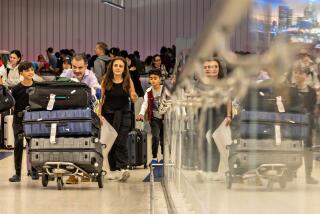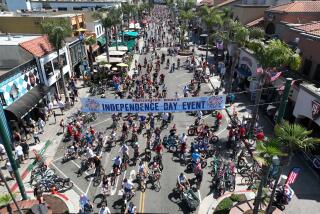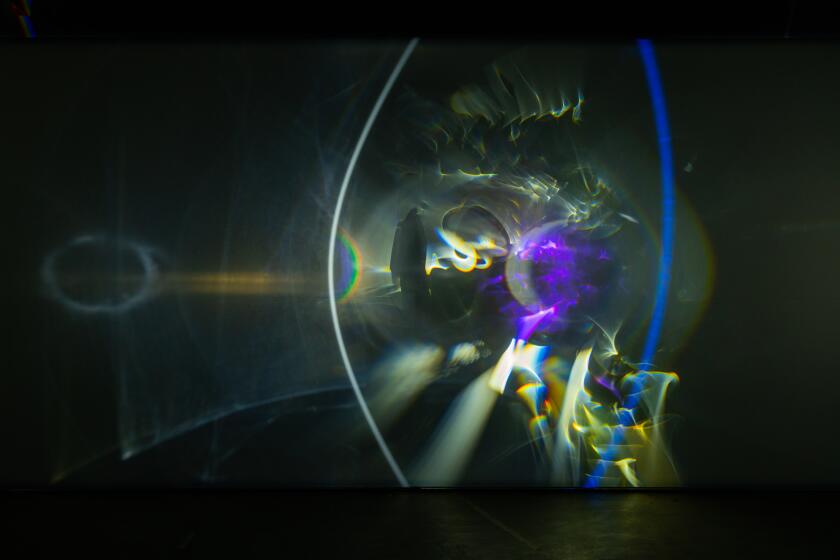Gas prices not seen impacting arts attendance so far
IT’S A tradition: Fourth of July, Hollywood Bowl, a capacity fireworks-concert crowd of about 17,500 oohing and aahing to the rockets’ red glare while the Los Angeles Philharmonic supplies a patriotic flourish.
This summer, with gas prices skyrocketing too, it took a little less internal combustion to bring everyone together for the celebration. A third of the concert-goers arrived by bus instead of automobile, taking advantage of the rolling caravan that converges on the Bowl from as many as 18 pickup points around Los Angeles County.
Attendance was identical to that of the previous Fourth, said Adam Crane, spokesman for the Philharmonic, which operates the county-owned Bowl -- but bus ridership was up 6%. And arrivals from the 14 park-and-ride lots serving far-flung areas were up 38%, suggesting that the longer the haul, the more appealing busing it to the Bowl might be.
“It’s still very early in our season, but it shows an upward trend,” Crane said.
On board with it
Thus far, there is no solid proof that $4.50-a-gallon regular is driving culture lovers en masse to buses and trains -- or that it’s discouraging many from going to concerts, plays and museums. But for anecdotal evidence, consider some of the Bowl patrons who took buses to the Philharmonic’s concert performance of “Carmen” the following weekend.
Steve and Meg Adler of Huntington Beach, who described themselves as arts lovers on a tight budget, said it had made a big difference to be able to catch a low-cost ride -- namely the $5 round-trip park-and-ride bus they took from Lakewood. He’s unemployed, and she is a music teacher. They’d been routinely passing up enticing discount ticket offers in L.A., they said, not wanting to make the drive.
“I’ll go, ‘I’d love to see that,’ but we can’t,” Meg Adler said from a back-of-the-bus perch as their packed white Tour Coach made its way up the Long Beach Freeway. It took about 45 minutes for the bus to negotiate the 28-mile trip and drop its 44 passengers at the Bowl’s entry plaza.
A while later, Ruby Quallsgray disembarked from a bus she’d boarded near her home in Pasadena. The trim retiree with short salt-and-pepper hair said her lightbulb moment for switching to mass transit for her many outings to the Bowl and downtown venues came three years ago, when the people sitting behind her at the Mark Taper Forum told her how easy it had been getting there by subway.
“Money is certainly a consideration,” Quallsgray said, but she’s also keen on saving energy and fighting pollution. “There’s the principle. How long are we going to support this?”
In the will-call line at the box office, Sophie Ambrose stood cradling a white bed pillow destined for the free seat she was waiting to claim under a special offer for concert-goers under 40. The speech pathologist, who lives in L.A.’s Pico-Robertson neighborhood, said she had leaped at “Carmen” because she could take a nonstop bus from Westwood.
Ambrose also said she had passed up other appealing cultural freebies in Long Beach and at the Huntington Library in San Marino. “It’s because of the gas, the driving, the traffic. All of that plays into it. They’re too far out.”
The fuel factor
Other arts consumers, however, clearly remain willing to drive: The Pacific Symphony in Irvine had its highest-grossing July Fourth fireworks concert ever, drawing more than 10,000 people to its summer home, the Verizon Wireless Amphitheatre -- a venue that does not list any mass transit options on its website.
Compared with tickets, meals and parking, gasoline is a small fraction of the cost of concert-going, said John Forsyte, the orchestra’s president, so “I don’t think that’s the driver” of many decisions.
As gas prices shot up throughout the spring, attendance at the Renée and Henry Segerstrom Concert Hall, the Pacific’s primary venue, held strong, Forsyte said.
All the same, some arts organizations have been experimenting with ways to draw people without drawing down gas tanks. For more than a year, the Pantages Theatre in Hollywood, with a Red Line subway stop at its doorstep, has been offering a 20% “Wicked Tuesday” discount to Metro riders who present a monthly transit pass. As of two weeks ago, 1,486 riders -- or about 25 per week -- had seen “Wicked” under the offer. But the takers have slowed to a trickle lately, despite high gasoline prices, said Martin Wiviott, general manager of the Pantages and the Broadway/L.A. series.
The Ahmanson Theatre at the Music Center, a short uphill walk from the Civic Center subway station, copied and multiplied the Pantages’ transit gambit during the recent run of “A Chorus Line.”
The 20% discount was good Tuesdays through Thursdays for anyone who brought an offer slip available on buses and subways. Yet just 33 people claimed the discount, said marketing director Jim Royce, out of 91,000 who saw the show. It takes time to build awareness, he said, and the experiment will continue, at least through next season.
Los Angeles Opera, on the other hand, is discontinuing last season’s venture in mass transit, in which it sponsored a single bus from Westwood to the Dorothy Chandler Pavilion for select weeknight performances of each production.
“It didn’t meet expectations, but we can reinstate it at any time” if the surge in gas prices fuels demand, spokesman Gary Murphy said.
45-minute benchmark
Meanwhile, officials at other cultural destinations -- including the Museum of Contemporary Art, the Los Angeles County Museum of Art, the Pasadena Playhouse, the Bowers Museum and Discovery Science Center in Santa Ana and the Laguna Art Museum and Festival of Arts in Laguna Beach -- said that shows and exhibitions since the spring run-up in gasoline prices have drawn good crowds or had normal ups and downs.
They attributed that more to specific attractions than to any public reluctance to burn fuel for the sake of an aesthetic experience.
Royce, the Center Theatre Group marketing chief, expects its three venues to continue drawing good crowds amid gas-fueled economic woes -- at least from within a 45-minute driving radius.
“In Los Angeles, that’s pretty much the benchmark before people start saying it’s too far or it’s not convenient,” he said.
“People cut back on travel, hotels, trips -- things they do outside their areas -- and look for activities closer to home. Generally, they’ll stay home, but not in their home, any more than they normally did.”
More to Read
The biggest entertainment stories
Get our big stories about Hollywood, film, television, music, arts, culture and more right in your inbox as soon as they publish.
You may occasionally receive promotional content from the Los Angeles Times.











